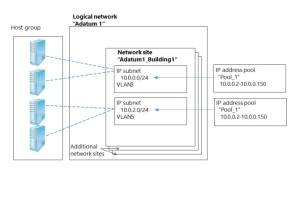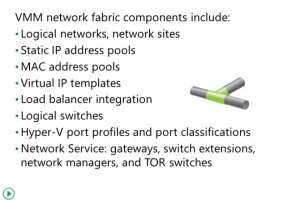Microsoft System Center 2012 R2 includes components that you can deploy and manage through the System Center 2012 R2 Virtual Machine Manager (VMM) console. The Fabric workspace in the VMM console simplifies working with a variety of storage and network technologies. Using these components, you can build and connect your virtualization network and storage infrastructure, thereby creating the underlying framework for deploying virtual machines, services, and clouds.
VMM Logical Networks
A VMM logical network is a collection of VMM
network sites, IP subnet information, and virtual
local area network (VLAN) information. You can
associate IP address pools with IP subnets that are
part of a logical network.
You can use logical networks in VMM to describe networks with different purposes and
then associate those networks with adapters. For example, you can create one logical network for traffic isolation (such as a network used for cluster node communication), and then associate the network adapters reserved for this communication with this VMM logical network.
At least one logical network must exist before you can deploy virtual machines and services. By default,when you add a Hyper-V host to VMM, if a physical network adapter on the host does not have anassociated logical network, VMM automatically creates and associates a logical network that matchesthe first Domain Name System (DNS) suffix label of the connection-specific DNS suffix.For example, if the DNS suffix for the host network adapter is adatum1.adatum.com, VMM creates a logical network with the name adatum1.
When you create a logical network, you can create one or more associated network sites. A network site isa collection of one or more subnets, VLANs, and subnet-VLAN pairs. You can control which host groupsconnect to a network site. For example, if you have a Seattle host group and a New York host group, and if you want to make the BACKEND logical network available to each, you can create two network sites forthe BACKEND logical network. You then can scope one network site to the Seattle host group (and any desired child host groups), and the other network site to the New York host group (and any desired child host groups).
When you associate one or more IP subnets with a network site, you can create an IP address pool. An IP address pool is a range of IP addresses within an IP subnet. For example, the range 10.0.0.2 to 10.0.0.150 would be an address pool within the 10.0.0.0/24 subnet. A static IP address pool enables VMM to assign static IP addresses to hosts and allows you to manage IP addresses for the virtual environment. Configuring static IP address pools is optional and you can assign addresses automatically through Dynamic Host Configuration Protocol (DHCP), if it is available on the network.
- What Is the VMM Networking Infrastructure?
In VMM, the networking infrastructure is a group of configurable network resources that you can use to create, model, organize, and manage your virtualized server network connectivity. The following sections describe the configurable components and their subcomponents. - Logical Networks
Logical networks are a set of logical network objects that you can use to model your network
environment. You can create multiple logical networks, and then associate them with one or
more host groups. For example, you can create a perimeter logical network, a development logical network, and a production logical network. When administrators or application administrators deploy virtual machines and services, they will be able to select a logical network without the need to understand the underlying networking infrastructure.
Network Sites
You can create network sites to associate subnets and VLANs with a location or department. You associate sites with the logical network, and then assign the host group that can use the network site.
MAC Address Pools
VMM can assign static media access control (MAC) addresses automatically to new virtual network devices on Windows-based virtual machines that are running on any managed Windows Server 2012 Hyper-V, VMware ESX, or Citrix XenServer host. VMM has two default static MAC address pools: the default MAC address pool for Hyper-V and Citrix XenServer, and the default VMware MAC address pool for VMware ESX hosts. You should use the default static MAC address pools only if you set the MAC address type for a virtual machine to Static. If you set the virtual machine setting to Dynamic, the hypervisor will assign the MAC address. You can use the default MAC address pools, or you can configure custom MAC address pools that you scope to specific host groups.
Virtual IP Templates
A virtual IP template contains a load balancer and related configuration settings for a specific type of network traffic. For example, you could create a template that specifies the load balancing behavior for HTTPS traffic on a specific load balancer manufacturer and model. These templates represent the best practices from a load balancer configuration standpoint. After you create a virtual IP template, users (including self-service users), can specify the virtual IP template to use when they create a service. When users model a service, they can choose an available template that best matches the needs of their load balancers and type of application.
Load Balancer Integration
By adding a load balancer to VMM, you can load balance requests to the service tier’s virtual machines. You can use Network Load Balancing (NLB), or you can add supported hardware load balancers through the VMM console. VMM includes NLB as an available load balancer, and it uses the round-robin method for load balancing. To add supported hardware load balancers, you must install a configuration provider that is available from the load balancer manufacturer. The configuration provider is a plug-in to VMM that translates Windows PowerShell commands to application programming interface (API) calls, which are specific to a load balancer manufacturer and model. Supported hardware load balancer devices are F5 BIG-IP, Brocade ServerIron, and Citrix Netscaler. You must obtain the load-balancer provider from the
load-balancer vendor, and then install it on the VMM management server.
Logical Switches
You can use logical switches to apply a single configuration to multiple hosts. You configure logical-toHyper-V port profiles and uplink profiles, port classification, and virtual-switch extensions. By using logical switches, you can enforce compliance among the host servers and reduce the time required to deploy and administer hosts.
Port Profiles
You can create and use two Hyper-V port profiles in VMM:
• Virtual network adapter port profiles. You create this type of profile for use by virtual machines and
hosts. These profiles have configurable offload, security, and bandwidth settings.
• Uplink port profiles. You configure this type of profile to use with uplink ports. You can configure the load-balancing algorithm and teaming mode.
Port Classifications
You can create port classifications, and then use them across multiple logical switches to help identify and group sets of features.
Network Service
A network service in VMM includes components such as gateways, virtual switch extensions, top-of-rack switches, and network managers. To add a network service, you must first install the associated provider, and then restart the System Center Virtual Machine Manager service. You can configure each of the following components by using the Add Network Service Wizard: - Gateway.In VMM, you can configure a gateway to allow network traffic in and out of a virtual machine network that is using network virtualization. You can configure this for local network routing which routes traffic between the virtual machine network and the physical network. Alternatively, you can configure it for remote network routing, which first creates a virtual private network (VPN) connection with another endpoint of a site-to-site VPN, and then routes in and out of the virtual machine network through the VPN tunnel.
- Virtual switch extensions.
Virtual switch extensions provide non-Microsoft vendors the ability to add monitoring, filtering, and forwarding extensions. For example, Cisco has created the Cisco Nexus 1000V for Hyper-V. This forwarding extension allows Cisco administrators to configure networking in VMM by using familiar Cisco commands. An example of a monitoring extension is Host sFlow, which exports performance metrics using the sFlow protocol.
• Network managers. Network managers enable you to use a non-Microsoft network management console to configure forwarding extensions. With network managers, you can manage settings such as logical networks, sites, and virtual machine networks.
• TOR switches. By using VMM to manage TOR switches, you can control physical switch ports. For example, you can create the corresponding VLAN and apply it to the physical port, thus keeping both physical and virtual switch settings synchronized.

